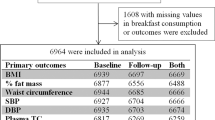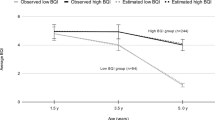Abstract
Objective:
An association between weight gain and breakfast skipping has been reported, but breakfast location was rarely considered. We investigated the prospective associations between breakfast location, breakfast skipping and body mass index (BMI) change in a large cohort of Chinese children.
Design:
Our baseline cohort consisted of 113 457 primary 4 (US grade 4) participants of the Hong Kong Department of Health Student Health Service in 1998–2000. Of these, 68 606 (60.5%) had complete records and were successfully followed-up 2 years later. Data on breakfast consumption and location were collected at both time points along with other lifestyle characteristics. BMI was derived from objectively measured height and weight. Associations between breakfast habits and BMI change were assessed by multivariable linear regression, adjusting for demographic, socioeconomic and lifestyle characteristics.
Results:
At baseline, 85.3, 9.4 and 5.2% of children had breakfast at home, away from home and skipped breakfast, respectively. Prospectively, having breakfast away from home (vs at home) predicted a greater BMI increase over two years (β=0.15; 95% CI: 0.11–0.18). Breakfast skipping had a comparable, slightly smaller effect (0.13; 0.09–0.18).
Conclusion:
Both breakfast skipping and eating breakfast away from home predict greater increases in BMI during childhood, the effect being slightly stronger in the latter. Having breakfast, particularly at home, could have important implications for weight management and reducing obesity in children. Further research is required to gain insight into potential underlying mechanisms.
This is a preview of subscription content, access via your institution
Access options
Subscribe to this journal
Receive 12 print issues and online access
$259.00 per year
only $21.58 per issue
Buy this article
- Purchase on Springer Link
- Instant access to full article PDF
Prices may be subject to local taxes which are calculated during checkout
Similar content being viewed by others
References
World Health Organization. Childhood overweight and obesity, 2010. [cited 14 May 2010]; available from: http://www.who.int/dietphysicalactivity/childhood/en/.
Timlin MT, Pereira MA, Story M, Neumark-Sztainer D . Breakfast eating and weight change in a 5-year prospective analysis of adolescents: project EAT (Eating Among Teens). Pediatrics 2008; 121: e638–e645.
Haug E, Rasmussen M, Samdal O, Iannotti R, Kelly C, Borraccino A et al. Overweight in school-aged children and its relationship with demographic and lifestyle factors: results from the WHO-Collaborative Health Behaviour in School-aged Children (HBSC) study. Int J Public Health 2009; 54: 167–179.
Dubois L, Girard M, Potvin Kent M, Farmer A, Tatone-Tokuda F . Breakfast skipping is associated with differences in meal patterns, macronutrient intakes and overweight among pre-school children. Public Health Nutr 2009; 12: 19–28.
Berkey CS, Rockett HRH, Gillman MW, Field AE, Colditz GA . Longitudinal study of skipping breakfast and weight change in adolescents. Int J Obes 2003; 27: 1258–1266.
Bes-Rastrollo M, Basterra-Gortari FJ, Sánchez-Villegas A, Marti A, Martínez JA, Martínez-González MA . A prospective study of eating away-from-home meals and weight gain in a Mediterranean population: the SUN (Seguimiento Universidad de Navarra) cohort. Public Health Nutr 2010; 13: 1356–1363.
Pereira MA, Kartashov AI, Ebbeling CB, Van Horn L, Slattery ML, Jacobs JDR et al. Fast-food habits, weight gain, and insulin resistance (the CARDIA study): 15-year prospective analysis. The Lancet 2005; 365: 36–42.
Jeffery R, Baxter J, McGuire M, Linde J . Are fast food restaurants an environmental risk factor for obesity? Int J Behav Nutr Phys Act 2006; 3: 2.
Agostoni C, Brighenti F . Dietary choices for breakfast in children and adolescents. Crit Rev Food Sci Nutr 2010; 50: 120–128.
Wang Y, Bentley ME, Zhai F, Popkin BM . Tracking of dietary intake patterns of Chinese from childhood to adolescence over a six-year follow-up period. J Nutr 2002; 132: 430–438.
Thompson OM, Ballew C, Resnicow K, Must A, Bandini LG, Cyr H et al. Food purchased away from home as a predictor of change in BMI z-score among girls. Int J Obes Relat Metab Disord 2003; 28: 282–289.
Tin SPP, Ho SY, Mak KH, Wan KL, Lam TH . Lifestyle and socioeconomic correlates of breakfast skipping in Hong Kong primary 4 schoolchildren. Prev Med. 2011; 52: 250–253.
Tin SPP, Ho SY, Mak KH, Wan KL, Lam TH . Breakfast skipping and change in body mass index in young children. Int J Obes. 2011; 35: 899–906.
Cohen J . A power primer. Psychol Bull 1992; 112: 155–159.
Student Health Service. Physical Exercise: Exercise and Keep Fit, 2010. Department of Health, Hong Kong, [cited 23 January 2010]; available from: http://www.studenthealth.gov.hk/english/health/health_pe/health_pe_ekf.html.
US Department of Health and Human Services. Physical Activity Guidelines for Americans: Active Children and Adolescents 2008. [cited 23 January 2011]; Available from: http://www.health.gov/PAGuidelines/guidelines/chapter3.aspx.
Committee on Public Education. Children, adolescents, and television. Pediatrics 2001; 107: 423–426.
Cole TJ, Bellizzi MC, Flegal KM, Dietz WH . Establishing a standard definition for child overweight and obesity worldwide: international survey. BMJ 2000; 320: 1240–1243.
Cole TJ, Flegal KM, Nicholls D, Jackson AA . Body mass index cut offs to define thinness in children and adolescents: international survey. BMJ 2007; 335: 194.
Himes JH . Challenges of accurately measuring and using BMI and other indicators of obesity in children. Pediatrics 2009; 124: S3–S22.
Field AE, Laird N, Steinberg E, Fallon E, Semega-Janneh M, Yanovski JA . Which metric of relative weight best captures body fatness in children? Obesity 2003; 11: 1345–1352.
Berkey CS, Colditz GA . Adiposity in adolescents: change in actual BMI works better than change in BMI z score for longitudinal studies. Ann Epidemiol 2007; 17: 44–50.
Corder K, van Sluijs EMF, Steele RM, Stephen AM, Dunn V, Bamber D et al. Breakfast consumption and physical activity in British adolescents. Br J Nutr 2010; 1: 1–6.
Anzman SL, Rollins BY, Birch LL . Parental influence on children's early eating environments and obesity risk: implications for prevention. Int J Obes 2010; 34: 1116–1124.
Pearson N, Biddle SJH, Gorely T . Family correlates of breakfast consumption among children and adolescents. A systematic review. Appetite 2009; 52: 1–7.
Berg MC, Jonsson I, Conner MT, Lissner L . Relation between breakfast food choices and knowledge of dietary fat and fiber among Swedish school children. J Adolesc Health 2002; 31: 199–207.
North K, Emmett P . Multivariate analysis of diet among three-year-old children and associations with socio-demographic characteristics. Eur J Clin Nutr 2000; 54: 73.
Yao M, McCrory MA, Ma G, Li Y, Dolnikowski GG, Roberts SB . Energy requirements of urban Chinese adults with manual or sedentary occupations, determined using the doubly labeled water method. Eur J Clin Nutr. 2002; 56: 575–584.
DeJong CS, van Lenthe FJ, van der Horst K, Oenema A . Environmental and cognitive correlates of adolescent breakfast consumption. Prev Med 2009; 48: 372–377.
Timlin MT, Pereira MA . Breakfast frequency and quality in the etiology of adult obesity and chronic diseases. Nutr Rev 2007; 65: 268–281.
Szajewska H, Ruszczynski M . Systematic review demonstrating that breakfast consumption influences body weight outcomes in children and adolescents in Europe. Crit Rev Food Sci Nutr 2010; 50: 113–119.
Keski-Rahkonen A, Kaprio J, Rissanen A, Virkkunen M, Rose RJ . Breakfast skipping and health-compromising behaviors in adolescents and adults. Eur J Clin Nutr 2003; 57: 842–853.
Utter J, Scragg R, Mhurchu CN, Schaaf D . At-home breakfast consumption among New Zealand children: associations with body mass index and related nutrition behaviors. J Am Diet Assoc 2007; 107: 570–576.
Sjoberg A, Hallberg L, Hoglund D, Hulthen L . Meal pattern, food choice, nutrient intake and lifestyle factors in The Goteborg Adolescence Study. Eur J Clin Nutr 2003; 57: 1569–1578.
Guthrie JF, Lin BH, Frazao E . Role of food prepared away from home in the American diet, 1977–78 versus 1994–96: changes and consequences. J Nutr Educ Behav 2002; 34: 140–150.
Zoumas-Morse C, Rock CL, Sobo EJ, Neuhouser ML . Children's patterns of macronutrient intake and associations with restaurant and home eating. J Am Diet Assoc 2001; 101: 923–925.
Nielsen SJ, Siega-Riz AM, Popkin BM . Trends in food locations and sources among adolescents and young adults. Prev Med 2002; 35: 107–113.
Ventura A, Birch L . Does parenting affect children's eating and weight status? Int J Behav Nutr Phys Act 2008; 5: 15.
Patrick H, Nicklas TA . A Review of Family and Social Determinants of Children′s Eating Patterns and Diet Quality. J Am Coll Nutr 2005; 24: 83–92.
Baxter SD, Thompson WO, Litaker MS, Frye FH, Guinn CH . Low accuracy and low consistency of fourth-graders’ school breakfast and school lunch recalls. J Am Diet Assoc. 2002; 102: 386–395.
Acknowledgements
This study was funded by the Health and Health Services Research Fund, Food and Health Bureau, Hong Kong SAR (05060781). We express our gratitude to all the staff and participants of the Student Health Service for their assistance in this study. We acknowledge Anita Lai for her help with data preparation and Gemma Knowles for her editorial assistance. Funding: Health and Health Services Research Fund (05060781).
Author information
Authors and Affiliations
Corresponding author
Ethics declarations
Competing interests
The authors declare no conflict of interest.
Rights and permissions
About this article
Cite this article
Tin, S., Ho, S., Mak, K. et al. Location of breakfast consumption predicts body mass index change in young Hong Kong children. Int J Obes 36, 925–930 (2012). https://doi.org/10.1038/ijo.2011.262
Received:
Revised:
Accepted:
Published:
Issue Date:
DOI: https://doi.org/10.1038/ijo.2011.262
Keywords
This article is cited by
-
Healthy breakfast habits and changes in obesity-related cardiometabolic markers in children: a longitudinal analysis
European Journal of Clinical Nutrition (2020)
-
Skipping breakfast in early childhood and its associations with maternal and child BMI: a study of 2–5-year-old Australian children
European Journal of Clinical Nutrition (2016)
-
Associations between breakfast frequency and adiposity indicators in children from 12 countries
International Journal of Obesity Supplements (2015)
-
No breakfast at home: association with cardiovascular disease risk factors in childhood
European Journal of Clinical Nutrition (2014)



